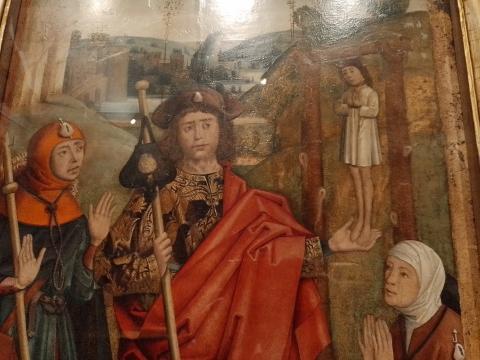The Miracle of the Gallows (before 1460)

Painted between 1435 and 1460 and attributed to Thierri Bouts (about 1415-1475), The Miracle of the Gallows is tempera on canvas on a panel.
According to legend, a young pilgrim was wrongly accused of theft and hanged. His parents prayed to St James, patron saint of pilgrims, and the young man was duly brought back to life. He is shown being supported on the saint's hand to represent the miracle. St James is shown with his symbols of a staff, purse and shell. The young man's grateful parents kneel at either side, and the landscape background suggests the pilgrim's long journey.
Bouts is a good painter, and clearly has a grasp of perspective and dimension, but his figures’ faces seem somewhat lacking in emotion. Even the resurrected victim of an unjust hanging looks like he has just watched an episode of Neighbours. Likewise, the earnest parents look fairly uninterested while St James has apparently attended to his saintly duties because he was on the rota for that week, and would rather have been elsewhere.
It is easy to sneer, and I do think Bouts a good painter. Yet medieval art amuses me for its neglect of human emotion, which the ancients depicted with skill in their sculpture. God made us to have emotions, feelings and passions. Having an excess is unhelpful, swinging us between moods as circumstances change. Having none makes us not unlike robots, creations of men. We should have joy, and fun, and passion, and anger, and surprise, and our faces should not be disconnected from our hearts. We should rule our emotions, and not be ruled by them, but let us not pretend they do not exist or are somehow further evidence of our sinful natures. They were put there by God Himself.
- Log in to post comments


 Sunday Worship 10.45am & 6.00pm
Sunday Worship 10.45am & 6.00pm